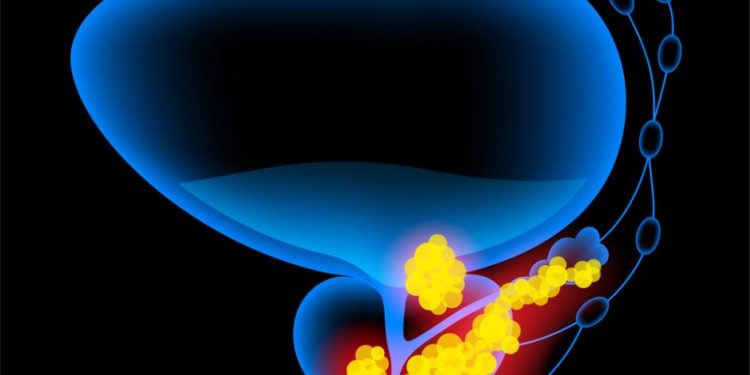Bladder cancer occurs when cells in the lining of your bladder become abnormal and start to grow out of control. It can affect anyone, but it’s more common in people over age 55 and in men. It’s also more likely if you smoke or have a family history of the disease.
1. Blood in the urine (hematuria)
A symptom that can be a sign of bladder cancer is blood in the urine, or hematuria. Seeing or even smelling traces of red in the urine can be frightening, but it’s important to get checked out by a doctor right away, especially if it happens more than once or if it lasts for months.
Hematuria can be visible to the naked eye (gross hematuria) or only detectable by lab tests (microscopic hematuria). It’s also possible to have hematuria and not know it because it may disappear for months at a time, only to return later. The color of the urine can range from slightly rusty to bright red, and it can appear in one spot or spread throughout the entire sample. It can also be a mix of different colors, including pink or dark yellow.
People with bladder cancer are more likely to have hematuria than those who don’t, but it can still be a symptom of other conditions as well. Urine tests can be used to diagnose a urine infection and help find the cause of the bleeding, and imaging tests can check for things like kidney stones or enlarged prostate.
A health care professional will talk to you about your medical history and do a physical exam, which includes a digital rectal exam for men and a pelvic exam for women. The health care professional will also use a tool called a cystoscope to see inside the bladder.
If the health care professional can’t find a reason for your hematuria, they might order more lab and imaging tests. These might include a CT or an MRI scan to create images of your urinary tract and look for tumors, kidney disease, or other problems. They might also test your blood for factors that can lead to bladder cancer, such as smoking or working with certain chemicals.
Most cases of hematuria don’t turn out to be bladder cancer, but if it doesn’t go away or it gets worse, it’s worth getting another opinion from a specialist. Bladder cancer is much less likely to come back after treatment if it’s caught early, so it’s important to make an appointment with a urologist as soon as you notice any signs of hematuria.
2. Pain when you pee (dysuria)
Pain or discomfort when you pee is a very common symptom of bladder cancer. It can feel like burning, stinging or sharp pain. It can be felt right where the urine passes out of your body or inside the body behind the pubic bone. Pain can be mild or severe and it may come and go. It can also be a sign of urinary tract infections (UTIs) or other conditions that affect the bladder and the surrounding tissue.
The bladder is a balloon-shaped organ that stores urine from the kidneys until it’s passed out of the body. It can get inflamed from a variety of conditions, including infections and inflammation of the urethra or prostate gland. This can cause pain when you urinate, especially if you have a high temperature.
You can also experience painful urination from medical conditions that affect the nervous system. If you’re experiencing any of these symptoms, you should see your doctor right away. The doctor will perform a physical exam and take a history of your symptoms. Then they will ask about the medications you’re taking and any over-the-counter remedies you’ve tried. They will also do a urine test, called a culture, to determine if you have an infection and what kind of bacteria are causing it.
Bladder cancer is most common in men over the age of 60, but it can happen to anyone. It’s also more likely to happen to people with a family history of bladder cancer, or who have certain health problems or lifestyle factors that increase the risk of the disease.
Blood in the urine is a very important symptom of bladder cancer. It can help the doctor diagnose the condition and find the best treatment option. But it’s important to remember that most cases of bladder cancer aren’t caused by blood in the urine. There are many other possible reasons to visit your doctor, so be sure to talk about all of your symptoms and signs with them. Often, there isn’t any reason to be concerned if you don’t have this symptom.
3. Frequent urinary tract infections (UTIs)
Many factors can cause frequent UTIs. They can be a sign of bladder cancer or they can happen because your urinary tract isn’t working properly (neurogenic bladder). If you have neurogenic bladder, it means that there are problems with the nerves to the bladder. This can be caused by a spinal cord injury or surgery, for example. Men and women who have neurogenic bladder may also have hormonal changes that affect how their urine moves through the bladder. This can also be a problem in people who have had bladder stones or have a condition that reduces their bladder muscle function, such as spina bifida.
If you have recurrent UTIs, it’s important to visit your doctor and explain what you are experiencing. They can test your urine to check for bacteria and cells, and they can do a physical exam. They can use a gloved finger to feel around your vagina or rectum to see if there is anything unusual.
UTIs can be very uncomfortable and they can also lead to serious complications if they are not treated quickly. One complication is permanent kidney damage, which can happen if the infection spreads up into the kidneys. Another complication is sepsis, which can be life-threatening and occurs if the infection goes untreated. If you have recurrent UTIs, drink plenty of fluids and make sure to take antibiotics as prescribed to prevent them from getting worse.
Blood in your urine is a common symptom of bladder cancer, but it can be difficult to recognise because it is often very slight. It may only be pink, red or rusty brown coloured and it might not always come with pain or other symptoms. It can also be confused with other conditions, such as postmenopausal bleeding from the uterus, or it can even be mistaken for a urinary tract infection.
Bladder cancer is most common in older adults and it usually starts in the cells that line the inside of your bladder. These are called urothelial cells and they can also be found in the kidneys and the tubes that carry urine from the kidneys to the bladder, called the ureters.
4. Weight loss
Bladder cancer is when cancer cells grow in the lining of your bladder, a hollow organ that stores urine (pee) before it passes out of your body. The cancer cells multiply out of control and grow into a mass, which is called a tumor. The tumor can also break apart and spread (metastasize) to other parts of your body. Bladder cancer is more common in men than in women. It is also more likely in people who are over 40. There are certain risk factors that can increase your chances of getting bladder cancer, including smoking. If you smoke, you are two-to-three times more likely to get the disease than nonsmokers. People who have a family history of the disease are more likely to get it as well. Having a job that exposes you to chemicals can also increase your chance of getting the disease.
The most common symptom of bladder cancer is blood in your urine (hematuria). Sometimes you might only have a small amount of blood, or it may not show up on a urine test. You might have this symptom for weeks or even months before being diagnosed. Many people who have this symptom will see their primary care doctor or gynecologist first, but they should go to a urologist for a second opinion.
Depending on the stage and grade of your cancer, treatment options will vary. Your doctor will take into account the type of cancer, its location in your bladder, and whether it has spread to other parts of your body. The stages of bladder cancer range from TA (confined to the lining of your bladder) through T2 and T3 (the cancer has spread through the muscle wall of your bladder).
Once cancer has spread, it can no longer be cured. However, treatment can help ease your symptoms and prolong your life. Your symptom control team (also known as your palliative care team) will help you to manage your symptoms as long as possible. This team is in most cancer units and hospices, and is available to visit you at home.









